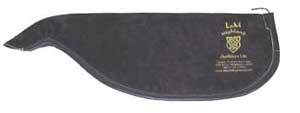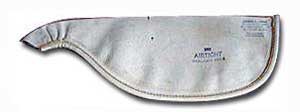The material used to make pipe bags continues to evolve, addressing the specific needs of pipers the world over. Bagpipe bags fall into two primary categories; tanned leather bags and synthetic material bags. We are also have an additional category combining both leather and synthetic materials. We expect to see a further evolution of bagpipe bag design and materials.
Tanned leather and sheepskin continue to enjoy wide use and appeal. Both perform well, however each will perform differently for different pipers and differently under different climatic conditions. We're also seeing other types of hide being brought into use. All require maintenance.
The tanned leather bag is generally easier to maintain airtight. Although various animal hides have been used, cowhide is the accepted standard. It is tanned to produce a smooth or "chromed" finished side, and a porous unfinished side.
The unfinished side will be facing outwards on the finished bag. The seam is joined first by glue, and then overlapped with a strip of leather which is sewn to the seam. (chromed side out this time). As an alternative to sewing the leather welt, some pipe bag manufacturers use rivets. The tanned leather bag will require seasoning before its initial use, but may require little seasoning thereafter. If the bag becomes dry and stiff, seasoning will renew the bag to playing condition in most instances. It is not unusual for a leather bag that is maintained through regular playing, proper storage, and occasional seasoning to last for many years.
The sheepskin and goatskin bags undergo identical treatment during tanning and manufacturing, however have unique qualities. Sheepskin is inclined to be much more porous than cowhide or other leathers. In order to ensure that the sheepskin bag remains airtight, it must be regularly maintained. This usually means that once every month or so it receives a thorough seasoning to seal its pores and seams, and then it is hung upside down to drain any excess seasoning. If loose seasoning remains in the bag, it is liable to find its way into the bagpipe's reeds during playing and cause considerable problems, if not damage, to the reeds. Because sheepskin is porous, it also acts as a sponge, and absorbs excess moisture that may occur during the playing of the bagpipe. All pipers blow a certain amount of moisture or wetness into the bag during the playing of the bagpipe. Some pipers are considered "wet blowers" and will have to take precautions to ensure that excess moisture problems do not occur in their instrument. Excess moisture problems may be compounded where weather conditions are more humid. Because of its high absorption qualities, the sheepskin bag is preferred by pipers where moisture is a problem.
A sheepskin bag will generally stretch quite a bit during its lifetime. The best sheepskin bags are very thick and difficult to manage when new. These bags stretch the least and last the longest. Once they are broken-in, they conform to your body and are extremely comfortable to play. A good sheepskin will provide the player with excellent moisture control and overall control (starts, stops, steady blowing) over their bagpipe. Most sheepskin bags can be expected to last somewhere between one and two playing seasons, on average.
Thinner sheepskin bags are inclined to stretch quite a bit, sometimes developing "thin spots" or areas where the hide is thinner than the general thickness of the bag. These thin spots will stretch more than the rest of the bag and become thinner yet, causing leakage of both seasoning and air. When a thin spot develops, repair may be possible. Otherwise the bag must be discarded.
I have repaired these thin spots by building a patch of silicone and nylon mesh, available at any building supplies store. I first make sure that the area to be repaired is dry on the surface receiving the patch. I spread silicone over the area, making sure that I extend the patch beyond the area that is leaking. Once the silicone has been applied, I place a length of nylon mesh into the silicone. This will provide additional strength and support. I use nylon drywall tape for the mesh. It’s easy to handle and works great. After the patch has cured, I finish the surface with another thin layer of silicone. Allow this to cure according to the manufacturer’s directions. Once the patch finished, it will last almost indefinitely. It's not pretty, however it works and no one will ever spot it under your bag cover.
Admittedly, the sheepskin bag requires greater attention and ongoing maintenance. It may, however, be absolutely critical if you are to get proper performance from your bagpipe. It is best to consult with a trusted and experienced individual prior to making the commitment to sheepskin.
Pipe bags are constructed with either a straight neck or a "swan neck." Either bag will perform well in terms of delivering air to the pipe chanter. The swan neck may feel more comfortable for some pipers. A straight neck bag may fold or roll when the chanter is being held in a vertical position while the bagpipe is played. Until the bag "relaxes," the chanter may be inclined to shoot straight out from the piper when released. This suggests that there is some effort into holding the chanter in the proper vertical position while the bagpipe is being played. In fact, there is little if any effort involved.
One of the most exciting (for pipers) improvements in hide bags has been the introduction of a zipper. This allows users access into the bag for the purpose of managing the moisture within.
Tanned leather and sheepskin continue to enjoy wide use and appeal. Both perform well, however each will perform differently for different pipers and differently under different climatic conditions. We're also seeing other types of hide being brought into use. All require maintenance.
The tanned leather bag is generally easier to maintain airtight. Although various animal hides have been used, cowhide is the accepted standard. It is tanned to produce a smooth or "chromed" finished side, and a porous unfinished side.
The unfinished side will be facing outwards on the finished bag. The seam is joined first by glue, and then overlapped with a strip of leather which is sewn to the seam. (chromed side out this time). As an alternative to sewing the leather welt, some pipe bag manufacturers use rivets. The tanned leather bag will require seasoning before its initial use, but may require little seasoning thereafter. If the bag becomes dry and stiff, seasoning will renew the bag to playing condition in most instances. It is not unusual for a leather bag that is maintained through regular playing, proper storage, and occasional seasoning to last for many years.
The sheepskin and goatskin bags undergo identical treatment during tanning and manufacturing, however have unique qualities. Sheepskin is inclined to be much more porous than cowhide or other leathers. In order to ensure that the sheepskin bag remains airtight, it must be regularly maintained. This usually means that once every month or so it receives a thorough seasoning to seal its pores and seams, and then it is hung upside down to drain any excess seasoning. If loose seasoning remains in the bag, it is liable to find its way into the bagpipe's reeds during playing and cause considerable problems, if not damage, to the reeds. Because sheepskin is porous, it also acts as a sponge, and absorbs excess moisture that may occur during the playing of the bagpipe. All pipers blow a certain amount of moisture or wetness into the bag during the playing of the bagpipe. Some pipers are considered "wet blowers" and will have to take precautions to ensure that excess moisture problems do not occur in their instrument. Excess moisture problems may be compounded where weather conditions are more humid. Because of its high absorption qualities, the sheepskin bag is preferred by pipers where moisture is a problem.
A sheepskin bag will generally stretch quite a bit during its lifetime. The best sheepskin bags are very thick and difficult to manage when new. These bags stretch the least and last the longest. Once they are broken-in, they conform to your body and are extremely comfortable to play. A good sheepskin will provide the player with excellent moisture control and overall control (starts, stops, steady blowing) over their bagpipe. Most sheepskin bags can be expected to last somewhere between one and two playing seasons, on average.
Thinner sheepskin bags are inclined to stretch quite a bit, sometimes developing "thin spots" or areas where the hide is thinner than the general thickness of the bag. These thin spots will stretch more than the rest of the bag and become thinner yet, causing leakage of both seasoning and air. When a thin spot develops, repair may be possible. Otherwise the bag must be discarded.
I have repaired these thin spots by building a patch of silicone and nylon mesh, available at any building supplies store. I first make sure that the area to be repaired is dry on the surface receiving the patch. I spread silicone over the area, making sure that I extend the patch beyond the area that is leaking. Once the silicone has been applied, I place a length of nylon mesh into the silicone. This will provide additional strength and support. I use nylon drywall tape for the mesh. It’s easy to handle and works great. After the patch has cured, I finish the surface with another thin layer of silicone. Allow this to cure according to the manufacturer’s directions. Once the patch finished, it will last almost indefinitely. It's not pretty, however it works and no one will ever spot it under your bag cover.
Admittedly, the sheepskin bag requires greater attention and ongoing maintenance. It may, however, be absolutely critical if you are to get proper performance from your bagpipe. It is best to consult with a trusted and experienced individual prior to making the commitment to sheepskin.
Pipe bags are constructed with either a straight neck or a "swan neck." Either bag will perform well in terms of delivering air to the pipe chanter. The swan neck may feel more comfortable for some pipers. A straight neck bag may fold or roll when the chanter is being held in a vertical position while the bagpipe is played. Until the bag "relaxes," the chanter may be inclined to shoot straight out from the piper when released. This suggests that there is some effort into holding the chanter in the proper vertical position while the bagpipe is being played. In fact, there is little if any effort involved.
One of the most exciting (for pipers) improvements in hide bags has been the introduction of a zipper. This allows users access into the bag for the purpose of managing the moisture within.
Hide Bags



